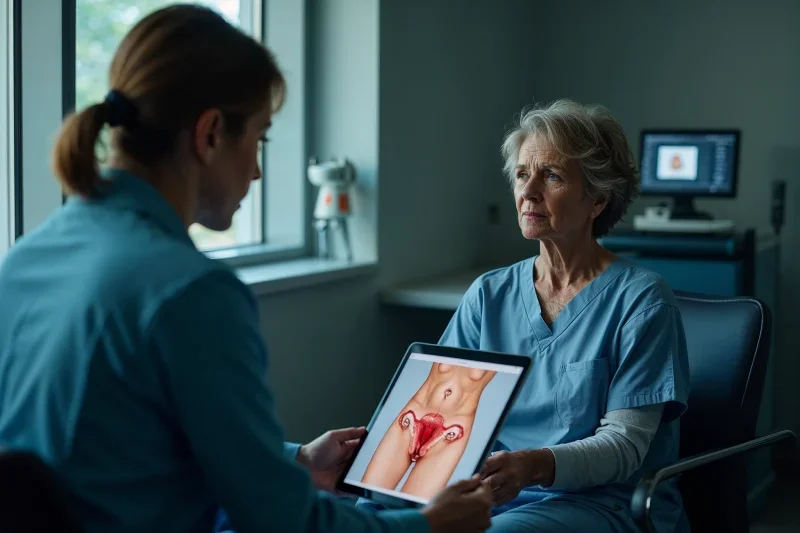Robotic Tubal Reversal Success Rates: What the Studies Show
Categories:
By: Ethan Cole
For many women who have undergone tubal ligation, the desire to conceive again can become a reality thanks to advances in surgical fertility restoration. Among the most promising options available today is robotic tubal reversal, a procedure that uses advanced microsurgical techniques to reconnect the fallopian tubes and restore natural fertility.
Unlike older open or laparoscopic approaches, robotic-assisted reversal combines 3D magnified visualization with precise, wristed instruments to improve surgical outcomes, minimize recovery time, and reduce complications.
This blog explores the most important question for anyone considering this procedure: What are the success rates? Drawing on published studies, real-world outcomes, and fertility data across age groups, we’ll break down what the research says about your chances of pregnancy after robotic tubal reversal—and the factors that can influence those results.
Key Takeaways
Robotic tubal reversal achieves pregnancy rates between 59% and 90%. Success is highest in women under 35 with healthy tubal length, offering a strong alternative to IVF with natural conception potential.
Success varies by age and tubal health. Younger women with longer residual tubal length and minimal damage achieve the best outcomes, while rates decline after age 40 due to diminished egg quality.
Robotic technology improves surgical precision and recovery. Advanced 3D visualization and wristed instruments enable meticulous tubal repair, reducing tissue trauma, lowering complication risks, and supporting faster recovery than traditional open surgery approaches.
Ectopic pregnancy remains a potential risk. Reported rates range between 3% and 10% following reversal, often depending on tubal damage severity, surgeon expertise, and microsurgical technique used during the procedure.
IVF may be preferable in select cases. Women over 40, patients with severe tubal damage, or couples facing male factor infertility may achieve better outcomes through IVF compared with surgical reversal.
What Is Robotic Tubal Reversal?
Robotic tubal reversal is a specialized fertility surgery designed to reconnect the fallopian tubes after a prior tubal ligation. The goal of the procedure is to restore natural fertility by allowing the egg and sperm to meet again through open and functional tubes. Using robotic-assisted technology, this approach offers increased surgical precision, reduced trauma to surrounding tissue, and a faster recovery compared to traditional methods.
How Robotic Tubal Reversal Works
The procedure is performed under general anesthesia using a minimally invasive technique. Small incisions are made in the abdomen, through which a robotic surgical system is inserted. The surgeon controls robotic arms from a console, guiding fine instruments with exceptional accuracy and stability.
The blocked or severed sections of the fallopian tubes are located, precisely aligned, and carefully reconnected using ultra-fine sutures under magnified 3D visualization. The goal is to restore patency—the ability of the tubes to carry the egg to the uterus—without scarring or functional loss.
Robotic vs Laparoscopic and Open Reversal
Robotic-assisted reversal offers several advantages over older surgical approaches:
Precision: Robotic tools allow more accurate alignment and suturing than standard laparoscopy
Visualization: 3D magnified imaging improves depth perception and tissue handling
Incision Size: Smaller than open surgery, reducing bleeding and scarring
Recovery: Faster healing and less postoperative discomfort compared to open reversal
Outcomes: Higher success potential in skilled hands, especially with complex cases
Why Robotic Technology Matters
The robotic system enhances the surgeon’s ability to perform delicate microsurgical maneuvers with consistency and control. This is especially important in tubal reversal, where the reconnection of tiny, soft-walled tubes must be exact. Improved visualization and dexterity contribute to higher success rates, lower complication risks, and better overall outcomes for fertility restoration.
Understanding Success Rates After Robotic Tubal Reversal
Success rates are one of the most critical factors when evaluating whether robotic tubal reversal is the right fertility treatment. While no procedure can guarantee pregnancy, robotic-assisted surgery offers strong outcomes—especially for well-selected candidates under age 40.
Reported Pregnancy Success Rates (General Range)
Studies show that pregnancy rates after robotic tubal reversal generally range between 59% and 80%, depending on factors such as patient age, tubal anatomy, and surgeon experience. Some high-volume clinics and recent research report success rates as high as 90% in women under 35 with no additional fertility complications.
These rates reflect natural conception without the need for assisted reproduction, which is a significant benefit for patients wanting to avoid ongoing medical intervention.
How These Rates Compare to Other Reversal Techniques
When compared to other surgical options, robotic tubal reversal offers competitive—and often superior—outcomes:
|
Technique |
Pregnancy Success Rate Range |
|
Open (microsurgical) |
~60–75% |
|
Laparoscopic |
~50–70% |
|
Robotic-assisted |
~59–90% |
Robotic technology allows for more accurate tubal alignment and microsurgical suturing, which can make a significant difference in long-term tubal function.
Ectopic Pregnancy Risks After Tubal Reversal
One of the key risks associated with any tubal reversal procedure is ectopic pregnancy—when the embryo implants in the fallopian tube instead of the uterus. The estimated risk after reversal is 3–10%, though some studies report slightly lower rates with robotic-assisted surgery due to improved tubal reconstruction.
Early monitoring after conception is essential to ensure the pregnancy is progressing normally and not located in the tubes.
Factors That Influence Success
While robotic tubal reversal offers promising success rates, individual outcomes depend on a variety of medical and surgical factors. These variables help determine how well the fallopian tubes can be restored and how likely pregnancy is after the procedure.
Age and Ovarian Reserve
Age is one of the strongest predictors of pregnancy success following tubal reversal. As a woman ages, egg quantity and quality decline, even if the tubes are successfully repaired. Success rates are generally highest for:
|
Age Group |
Pregnancy Success Rate Range |
|
Under 35 |
70–90% |
|
35 to 40 |
60–70% |
|
Over 40 |
30–40% |
Ovarian reserve testing (such as AMH levels) may be used to assess fertility potential before surgery.
Type of Tubal Ligation and Tubal Health
Not all tubal ligation methods are equally reversible. The success of the reversal depends heavily on how the tubes were initially blocked and how much healthy tube remains.
Clips and rings: Most reversible, with minimal damage
Cautery (burning): Can shorten tubes significantly, reducing success
Tubal removal or fimbriectomy: Often not reversible, depending on extent
Tubal length: Remaining tube should be at least 4–6 cm for best outcomes
A review of operative records and imaging helps determine whether reversal is feasible.
Surgeon Skill and Surgical Technology Used
Surgical experience and the use of advanced technology—like robotic-assisted microsurgery—play a key role in achieving optimal results. Skilled surgeons can align and suture the delicate tubal segments with minimal trauma, using:
3D visualization for detailed anatomical control
Wristed instruments for precision suturing
Fine sutures and intraoperative dye testing for patency verification
Robotic-assisted procedures improve consistency and minimize surgical errors, which can enhance fertility outcomes.
How Robotic Tubal Reversal Surgery Works
Understanding the surgical process helps patients feel more confident and prepared. Robotic tubal reversal is a delicate procedure that uses advanced technology to reconnect the fallopian tubes with the goal of restoring natural fertility—while minimizing trauma and recovery time.
Step-by-Step Breakdown of the Procedure
The surgery is performed under general anesthesia in an outpatient surgical center or hospital. Here’s how the process typically unfolds:
Small incisions are made in the abdomen to insert robotic ports.
The robotic surgical system is docked, and the surgeon controls the robotic arms from a nearby console.
The disconnected ends of the fallopian tubes are carefully located, trimmed, and aligned under high magnification.
Microsurgical suturing is used to reconnect the tubal segments using ultra-fine, absorbable threads.
Intraoperative dye testing is performed to confirm tubal patency (i.e., that the tubes are open and functional).
Incisions are closed with dissolvable sutures, and patients are moved to recovery.
The entire procedure typically takes 1.5 to 3 hours, depending on case complexity.
Role of Robotic Technology During Surgery
The robotic platform provides unmatched precision, control, and visibility. With 3D high-definition imaging, the surgeon can visualize fine anatomical details of the tubes and surrounding structures. Wristed instruments replicate the movement of the human hand but with far greater dexterity, allowing for meticulous suturing with less tissue trauma.
This precision is especially beneficial in cases involving scarring, shortened tubes, or complex ligation types.
What to Expect During Recovery
Most patients return home the same day or after a short overnight stay. Recovery is typically quicker and less painful than traditional open surgery.
Week 1: Rest and limited movement; discomfort managed with oral pain medication
Week 2–3: Gradual return to daily activities and light exercise
Week 4–6: Most patients resume full activity and can begin trying to conceive (as advised by their surgeon)
Follow-up appointments are scheduled to monitor healing and confirm readiness for pregnancy.
Benefits of Robotic Tubal Reversal
Robotic-assisted tubal reversal offers several clinical and recovery advantages that make it a preferred choice for many patients. Compared to traditional open or laparoscopic approaches, robotic surgery enhances precision, reduces trauma, and often leads to better fertility outcomes with less physical downtime.
Enhanced Precision and Improved Surgical Outcomes
The robotic system enables the surgeon to perform highly delicate microsurgical tasks with greater control than standard techniques allow. This includes aligning and suturing the fallopian tubes using ultra-fine stitches under 3D magnification—crucial steps for maintaining tubal function and patency.
Improved accuracy leads to stronger tubal healing, lower scarring, and higher success rates, especially in patients with complex ligation types or shorter remaining tubal segments.
Less Invasive, Less Painful, Faster Recovery
Robotic tubal reversal is a minimally invasive procedure, which means fewer and smaller incisions. As a result, most patients experience:
Reduced blood loss and tissue trauma
Minimal postoperative pain
Lower risk of wound complications
Shorter hospital stays (often same-day discharge)
Faster return to normal activity (within 2–4 weeks)
This makes robotic surgery particularly appealing for patients concerned about downtime or long recovery periods.
Lower Risk of Complications
With improved visibility and fine motor control, robotic-assisted surgery minimizes unintended tissue damage and improves surgical consistency. This translates to a lower risk of:
Infection
Internal adhesions
Prolonged recovery
Failed reconnection of the tubes
In experienced hands, robotic tubal reversal is both safe and effective, with complication rates lower than those seen in traditional open reversal surgeries.
What the Research Says: Study-Based Outcomes
Success rates for robotic tubal reversal are well-supported by current clinical research and real-world fertility outcomes. This data helps patients understand their chances of natural conception and how factors like age and tubal condition shape results.
Key Study Findings by Age Group
Success rates vary by age, as fertility naturally declines with time. Here’s what the latest evidence shows:
Women under 35
Pregnancy rates range from 70% to 90%, with live birth rates between 65% and 80%.
Outcomes are strongest in patients with minimal scarring and healthy remaining tubal length.Ages 35–40
Pregnancy success ranges from 60% to 70%.
Fertility decline begins to impact outcomes due to egg quality and implantation changes.Over 40
Success rates fall to 30% to 40%, depending on ovarian reserve and tubal health.
While pregnancy is still possible, outcomes are more time-sensitive and variable.
Real-World Clinic Success Rates
Some fertility clinics report consistent success figures based on actual patient data:
Pregnancy rates: 65% to 85%
Live birth rates: 60% to 75%
Ectopic pregnancy rates: 3% to 10%
These results depend heavily on proper patient selection, the surgeon’s experience, and baseline reproductive health.
Robotic Reversal vs IVF: What the Data Shows
Robotic tubal reversal offers a cost-effective and natural alternative to IVF for many patients—especially those under 38.
For women under 38, reversal often produces equal or higher live birth rates than IVF, with the advantage of a one-time surgery followed by unlimited natural conception attempts.
For women over 40, IVF may be more effective per cycle. It bypasses the fallopian tubes entirely and allows for embryo selection, though it often requires multiple costly cycles.
Unlike IVF, where each attempt carries new expenses and success variability, robotic reversal allows patients to try conceiving naturally over time without repeating procedures.
Risks and Special Considerations
Robotic tubal reversal is considered a safe and effective fertility treatment, but like any surgical procedure, it comes with certain risks and limitations. Understanding these potential concerns can help you make a fully informed decision and prepare for both the physical and emotional aspects of the journey.
Surgical and Postoperative Risks
While complications are uncommon in experienced hands, the following risks may occur during or after surgery:
Infection at the incision site or internally
Bleeding or hematoma formation
Adverse reaction to anesthesia
Internal scar tissue (adhesions)
Damage to nearby organs (bladder, bowel, vessels)
Ectopic pregnancy (3% to 10% incidence)
Incomplete tubal healing or blockage
Persistent pelvic discomfort
Your surgeon will review your health history and take steps to minimize these risks through careful surgical planning and technique.
Physical and Emotional Considerations
Although recovery is typically shorter with robotic surgery, patients may still experience soreness, fatigue, and emotional ups and downs in the weeks following the procedure. For those hoping to conceive quickly, anxiety can arise if pregnancy does not happen right away. It's important to give your body time to heal and to discuss realistic expectations with your care team.
Support systems, counseling, or fertility coaching may be helpful in managing the emotional aspects of this process.
When IVF May Be the Preferred Option
In some cases, IVF may offer a more appropriate or effective path to pregnancy. This may be true if:
The fallopian tubes were removed or irreparably damaged
There is significant scar tissue or very short remaining tubal segments
The patient is over age 40 with low ovarian reserve
Rapid conception is medically or personally urgent
Male factor infertility or other conditions require assisted reproduction
For patients who fall into these categories, IVF can bypass the tubes entirely and may offer a more controlled and timely solution.
Preparing for Robotic Tubal Reversal Surgery
Proper preparation can significantly improve both the safety and success of robotic tubal reversal. From preoperative evaluations to post-surgery care, knowing what to expect at each stage helps reduce stress and optimize outcomes.
Preoperative Consultations and Testing
Before surgery, your surgeon will conduct a thorough medical evaluation to determine whether you’re a good candidate for robotic tubal reversal. This typically includes:
Review of your fertility and surgical history
Physical exam and pelvic ultrasound
Blood work to assess ovarian reserve (e.g., AMH, FSH levels)
Imaging or review of prior tubal ligation records, if available
Partner semen analysis (if applicable)
This step ensures that the fallopian tubes are likely to be repairable and that no other significant fertility barriers are present.
What to Expect on the Day of Surgery
Robotic tubal reversal is usually performed in a surgical center or hospital under general anesthesia. On the day of surgery:
You’ll check in a few hours before the scheduled procedure
After anesthesia is administered, the surgical team will perform the reversal using robotic-assisted technology
The operation typically lasts 1.5 to 3 hours
Once awake and stable, most patients are discharged the same day, though an overnight stay may be recommended in some cases
Detailed instructions will be provided to ensure a smooth and safe return home.
Postoperative Care and Follow-Up
Recovery after robotic tubal reversal is usually faster than with open surgery. Most patients can expect:
Mild to moderate abdominal discomfort for a few days
Return to light activity within one to two weeks
Avoidance of strenuous exercise or heavy lifting for at least four weeks
A follow-up visit within 1–2 weeks to check healing and discuss next steps
You’ll also be advised when it’s safe to begin trying to conceive—typically after the first menstrual cycle post-surgery.
Take the next step in your fertility journey with Dr. Jason Neef. Schedule a consultation today to learn more about your options and what may be right for you.
Restore your fertility with expert robotic tubal reversal today.
Call (817) 568-8731Categories:
Frequently Asked Questions
-
Recent studies show robotic tubal reversal pregnancy rates of about 65% to 80% within 12 months, with many pregnancies occurring in the first 6 months, especially in women under 35 with healthy tubal length.
-
Robotic tubal reversal pregnancy rates (59%-90%) and live birth rates (~60%-75%) are comparable or superior to laparoscopy (50%-70%) and similar to microsurgery (~60%-75%), benefiting from improved precision and visualization.
-
Higher ectopic rates (3%-10%) after robotic reversal are linked to surgeon experience, tubal damage severity, and suboptimal anastomosis technique, reflecting variability in surgical skill and patient factors.
-
Success notably declines with age: under 35, pregnancy up to 90%; ages 35-40, around 60-70%; over 40, rates drop near 30-40%. Age-related egg quality reduction is a key factor.
-
Robotic reversal has low complication rates similar to laparoscopy, with advantages of minimal tissue trauma, less blood loss, smaller incisions, faster recovery, and shorter hospital stays.
-
Longer residual tubal length (>4 cm) after reversal correlates with higher pregnancy rates due to better tubal function; shorter lengths reduce success.
-
Precise microsurgical technique with robotic tools enhances tubal alignment and patency, increasing pregnancy rates while lowering ectopic risk.
-
Robotic surgery typically halves recovery time versus open surgery, with patients resuming normal activity within days rather than weeks.
-
The original sterilization type (clip, ring, cautery) influences tubal damage severity, affecting reversal complexity and pregnancy likelihood.
-
IVF may be preferred for women over 40, severe tubal damage, or male factor infertility; robotic reversal suits younger patients desiring natural conception.












